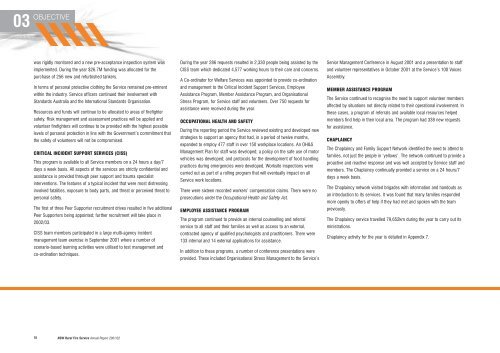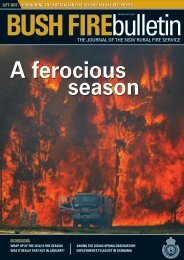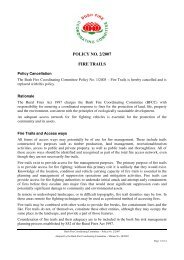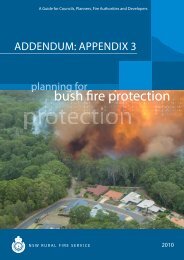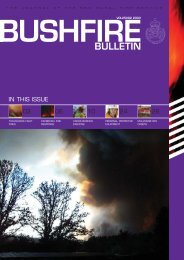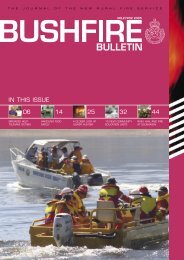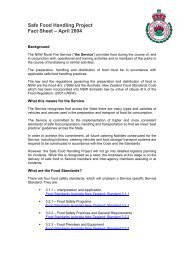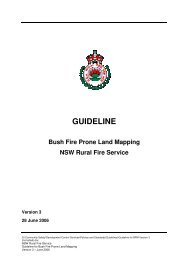Volunteer Professionals - NSW Rural Fire Service - NSW Government
Volunteer Professionals - NSW Rural Fire Service - NSW Government
Volunteer Professionals - NSW Rural Fire Service - NSW Government
You also want an ePaper? Increase the reach of your titles
YUMPU automatically turns print PDFs into web optimized ePapers that Google loves.
03 OBJECTIVE<br />
was rigidly monitored and a new pre-acceptance inspection system was<br />
implemented. During the year $26.7M funding was allocated for the<br />
purchase of 256 new and refurbished tankers.<br />
In terms of personal protective clothing the <strong>Service</strong> remained pre-eminent<br />
within the industry. <strong>Service</strong> officers continued their involvement with<br />
Standards Australia and the International Standards Organisation.<br />
Resources and funds will continue to be allocated to areas of firefighter<br />
safety. Risk management and assessment practices will be applied and<br />
volunteer firefighters will continue to be provided with the highest possible<br />
levels of personal protection in line with the <strong>Government</strong>’s commitment that<br />
the safety of volunteers will not be compromised.<br />
CRITICAL INCIDENT SUPPORT SERVICES (CISS)<br />
This program is available to all <strong>Service</strong> members on a 24 hours a day/7<br />
days a week basis. All aspects of the services are strictly confidential and<br />
assistance is provided through peer support and trauma specialist<br />
interventions. The features of a typical incident that were most distressing<br />
involved fatalities, exposure to body parts, and threat or perceived threat to<br />
personal safety.<br />
The first of three Peer Supporter recruitment drives resulted in five additional<br />
Peer Supporters being appointed; further recruitment will take place in<br />
2002/03.<br />
CISS team members participated in a large multi-agency incident<br />
management team exercise in September 2001 where a number of<br />
scenario-based learning activities were utilised to test management and<br />
co-ordination techniques.<br />
During the year 286 requests resulted in 2,330 people being assisted by the<br />
CISS team which dedicated 4,577 working hours to their care and concerns.<br />
A Co-ordinator for Welfare <strong>Service</strong>s was appointed to provide co-ordination<br />
and management to the Critical Incident Support <strong>Service</strong>s, Employee<br />
Assistance Program, Member Assistance Program, and Organisational<br />
Stress Program, for <strong>Service</strong> staff and volunteers. Over 750 requests for<br />
assistance were received during the year.<br />
OCCUPATIONAL HEALTH AND SAFETY<br />
During the reporting period the <strong>Service</strong> reviewed existing and developed new<br />
strategies to support an agency that had, in a period of twelve months,<br />
expanded to employ 477 staff in over 150 workplace locations. An OH&S<br />
Management Plan for staff was developed; a policy on the safe use of motor<br />
vehicles was developed; and protocols for the development of food handling<br />
practices during emergencies were developed. Worksite inspections were<br />
carried out as part of a rolling program that will eventually impact on all<br />
<strong>Service</strong> work locations.<br />
There were sixteen recorded workers’ compensation claims. There were no<br />
prosecutions under the Occupational Health and Safety Act.<br />
EMPLOYEE ASSISTANCE PROGRAM<br />
The program continued to provide an internal counselling and referral<br />
service to all staff and their families as well as access to an external,<br />
contracted agency of qualified psychologists and practitioners. There were<br />
133 internal and 14 external applications for assistance.<br />
In addition to these programs, a number of conference presentations were<br />
provided. These included Organisational Stress Management to the <strong>Service</strong>’s<br />
Senior Management Conference in August 2001 and a presentation to staff<br />
and volunteer representatives in October 2001 at the <strong>Service</strong>’s 100 Voices<br />
Assembly.<br />
MEMBER ASSISTANCE PROGRAM<br />
The <strong>Service</strong> continued to recognise the need to support volunteer members<br />
affected by situations not directly related to their operational involvement. In<br />
these cases, a program of referrals and available local resources helped<br />
members find help in their local area. The program had 338 new requests<br />
for assistance.<br />
CHAPLAINCY<br />
The Chaplaincy and Family Support Network identified the need to attend to<br />
families, not just the people in ‘yellows’. The network continued to provide a<br />
proactive and reactive response and was well accepted by <strong>Service</strong> staff and<br />
members. The Chaplaincy continually provided a service on a 24 hours/7<br />
days a week basis.<br />
The Chaplaincy network visited brigades with information and handouts as<br />
an introduction to its services. It was found that many families responded<br />
more openly to offers of help if they had met and spoken with the team<br />
previously.<br />
The Chaplaincy service travelled 79,652km during the year to carry out its<br />
ministrations.<br />
Chaplaincy activity for the year is detailed in Appendix 7.<br />
18<br />
<strong>NSW</strong> <strong>Rural</strong> <strong>Fire</strong> <strong>Service</strong> Annual Report 2001/02


